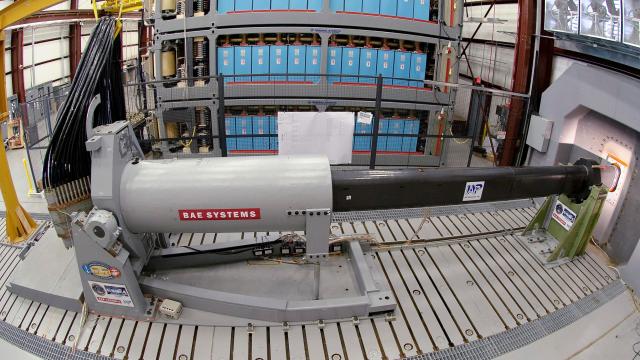As the US commitment to its long-running railgun program appears ready to wane, China’s own program might be winding up, recent reports suggest.
The US Navy’s railgun being tested in 2012. Photo: AP
According to Ars Technica and TechCrunch, photos appear to show a railgun mounted on a Chinese warship design normally used to land tanks.
An anonymous analyst cited by Ars, stated that the People’s Liberation Army Navy ship — christened the Haiyang Shan — was used to mount the railgun because its large dry deck could be used to house the massive power supply and control system needed to fire the weapon:
The Haiyang Shan is part of China’s East Sea Fleet (and over the past two years a frequent visitor to the artificial islands being constructed by China in disputed waters of the South China Sea) … That dedicated power system is essential, because even more modern Chinese warships lack the electrical generation capacity to power a railgun. In fact, only the U.S. Navy’s Zumwalt class destroyers have enough generation capacity to power one, as they were designed with future directed energy weapons in mind.
I translated one of the most well-known former PLAN officer’s analysis, who has engaged in the building of PLAN warships for dozens years. pic.twitter.com/odMXtpB9pw
— dafeng cao (@dafengcao) February 1, 2018
As TechCrunch noted, several signs that the ship does indeed have a railgun mounted on it are present, such as relatively short barrel covered with a thick housing that could contain acceleration components, the recent design of the ship, and shipping containers behind the gun that could contain “power and operational infrastructure” that the Chinese navy hasn’t managed to miniaturize yet. It’s all speculation, but it’s plausible.
Railguns use electromagnets to accelerate solid metallic projectiles to high speeds (around 7,242km per hour), unlike conventional weapons that use propellant and explosive shells. That would make them very deadly weapons if they ever progress past the research and development phase — railguns potentially double the range of naval warships from 80 to 160km and the solid metal rounds are cheaper than expensive missiles and can penetrate straight through heavy armour. Railguns could also make the most dangerous part of a warship, magazines loaded with hundreds or thousands of high-explosive shells, obsolete.
But firing railguns requires huge amounts of power. Firing the guns at those huge levels of electrical power, which is necessary to ensure the explosive-free projectile still has enough kinetic energy when it reaches its target, has a nasty habit of tearing their barrels to shreds. Developing new classes of ship designed around the weapons system is an expensive endeavour and one that the US has apparently lost interest in.
The U.S. program, which has cost half a billion dollars since 2005, may be winding down due to disinterest from the recently declassified Strategic Capabilities Office, according to a recent piece in military publication Task and Purpose.
It turns out that the SCO is reportedly more interested in the gun’s hyper-velocity projectile, a low-drag guided spike that can be fired using existing weapons systems and could potentially be deployed right now, and less interested in funding the extensive testing required to ensure the railgun could be mounted on naval ships anytime soon.
None of this means that the Chinese military is beating the US to a railgun — even if it is a railgun, it’s probably an early-stage prototype, and they’d likely run into the exact same design problems that saw the SCO throw up its hands in frustration. Nor is it particularly clear that anyone should be particularly concerned at this moment, since the U.S. Navy is far more powerful than its Chinese equivalent with or without railguns.
